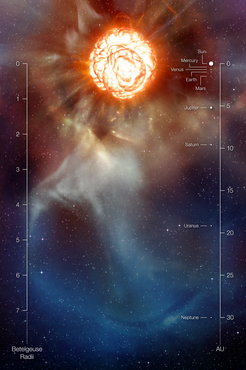Unveiling the true face of a gigantic star
High-resolution observations of the star Betelgeuse show for the first time the violent gas movements on its surface
An international team of astronomers, led by Keiichi Ohnaka at the Max Planck Institute for Radio Astronomy (MPIfR) in Bonn, has made the most high resolution images of a dying giant star to date. For the first time they could show how the gas is moving in different areas over the surface of a distant star. This was made possible by combining three 1.8 metre telescopes as an interferometer, giving the astronomers the resolving power of a virtual, gigantic 48 metre telescope. Using the ESO VLT Interferometer in Chile, they discovered that the gas in the dying star’s atmosphere is vigorously moving up and down, but the size of such "convection cell or bubble" is as large as the star itself. These colossal bubbles are a key for pushing material out of the star’s atmosphere into space, before the star explodes as a supernova. (Astronomy & Astrophysics, 2009, in press).

When one looks up at the clear night sky in winter, it is easy to spot a bright, orange star on the shoulder of the constellation Orion (the Hunter) even in light-flooded large cities. This is the star Betelgeuse. It is a gigantic star, which is so huge as to almost reach the orbit of Jupiter, swallowing the inner planets Mercury, Venus, Earth, and Mars, when placed at the centre of our solar system. It is also glaringly bright, emitting 100 000 times more light than the Sun. Betelgeuse is a so-called red supergiant and approaching the end of its short life of several million years. Red supergiants shed a large amount of material made of various molecules and dust, which are recycled for the next generation of stars and planets possibly like the Earth. Betelgeuse is losing material equivalent to the Earth’s mass every year.
How do such giant stars lose mass, which would normally be bound to the star by the gravitational pull? This is a long-standing mystery. The best way to tackle this issue is to observe the situation where the material is ejected from a star’s surface, but this is a very challenging task. Although Betelgeuse is such a huge star, it looks like a mere reddish dot even with the today’s largest, 8 - 10 metre telescopes, because the star is 640 light years away.
Therefore, astronomers need a special technique to overcome this problem. By combining two or more telescopes as a so-called interferometer, astronomers can achieve a much higher resolution than provided with individual telescopes. The Very Large Telescope Interferometer (VLTI) on Cerro Paranal in Chile, operated by the European Southern Observatory (ESO), is one of the world’s largest interferometer. A team of astronomers in German, French, and Italian institutions observed Betelgeuse with the AMBER instrument operating at near-infrared wavelengths. The resolving power achieved with AMBER is so great that one can recognize a 1-Euro coin placed on the Brandenburg Gate in Berlin from Bonn.
"Our AMBER observations mark the sharpest images ever made of Betelgeuse", says Keiichi Ohnaka at the MPIfR, the first author of the publication presenting the result. "And for the first time, we have spatially resolved the gas motion in the atmosphere of a star other than the Sun. Thus, we could observe how the gas is moving in different areas over the star’s surface."
The AMBER observations have revealed that the gas in Betelgeuse’s atmosphere is moving vigorously up and down. The size of these "bubbles" is also gigantic, as large as the supergiant star itself (that is, one bubble as large as the orbit of Mars is moving at some 40 000 km/h). While the origin of these bubbles is not yet entirely clear, the AMBER observations have shed new light on the question about how red supergiant stars lose mass: such colossal bubbles can expel the material from the surface of the star into space. It also means that the material is not spilling out in a quiet, ordered fashion, but is flung out more violently in arcs or clumps.
The death of the gigantic star, which is expected in the next few thousand to hundred thousand years, will be accompanied by cosmic fireworks known as a supernova like the famous SN1987A. However, as Betelgeuse is much closer to the Earth than SN1987A, the supernova can be clearly seen with the unaided eye, even in daylight.
